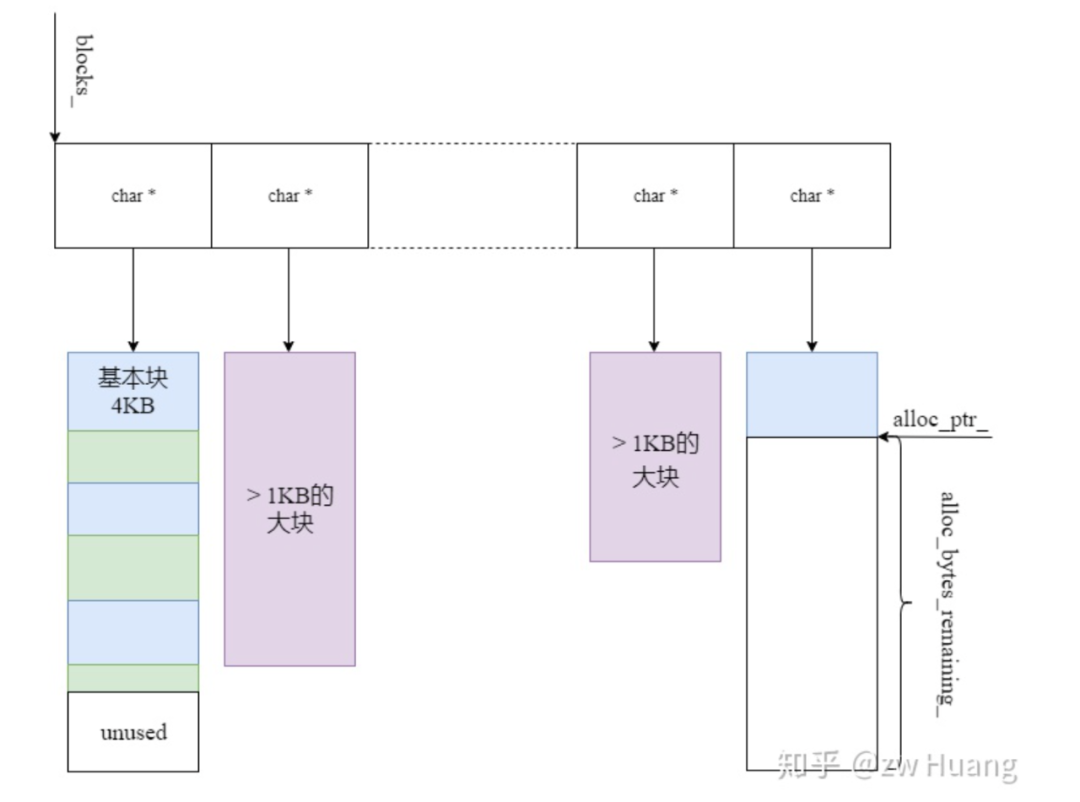本文主要介绍开源项目LevelDB中的内存管理器(也可称为内存池)Arena的实现,LevelDB的大部分内存管理依赖于C++语言的默认实现,也就是不对内存进行管理。只是在MemTable的实现中用到了一个简单的内存管理器(Arena)。
Arena目的
LevelDB中MemTable的内部实现Skip List写入时,需要分配新节点,大量节点的直接分配(调用malloc/free或者new/delete)可能会带来较多的内存碎片(大量很小的键值对插入),且每个调用平均的开销比较大影响运行效率,关乎数据库的性能。
因此,LevelDB为每个MemTable都绑定了一个Arena来管理内存,在MemTable进行minor compact后,MemTable销毁时进行统一释放。
设计思想
Arena的内存分配的方式,首先使用new预分配一块比较大的内存,需要使用小块内存时,从这块大内存里面继续分配,此时分配只需要移动指针或者更新变量的,非常高效。
主要涉及的变量:
// 当前能使用内存的起始位置(已经通过new分配下来了)
char* alloc_ptr_;
// 当前已申请的剩余字节数
size_t alloc_bytes_remaining_;
// 保存每次通过new分配下来的内存起始位置
std::vector<char*> blocks_;
1)需要分配的字节数不大于当前已申请的剩余字节数,直接从剩余的字节中分配,调整alloc_ptr_及alloc_bytes_remaining_的值;
2)需要分配的字节数大于当前已申请的剩余字节数,且大于1KB,通过new向操作系统申请需要的内存空间,blocks_保存起始地址,alloc_ptr_及alloc_bytes_remaining_不变;
3)需要分配的字节数大于当前已申请的剩余字节数,且不大于1KB,通过new向操作系统申请4KB内存空间(之前已申请的剩余字节数将浪费),blocks_保存起始地址,并从该4KB内存中拿出需要的内存空间,调整alloc_ptr_及alloc_bytes_remaining_的值。该种情况将造成一定内存空间的浪费。
对于释放内存,Arena不支持单独释放某个块,而是只能销毁整个Arena。这是和Arena的使用场景有关的,Arena存储的是内存中的键值对,对于LevelDB来说,只有插入操作,没有实际的删除操作,所以不需要释放一块内存。而当一个Arena里的数据dump到SSTable后,只需要释放Arena里所有的内存。
Arena的内存分配如下图所示(转自知乎):

结构声明
// from LevelDB util/arena.h
class Arena {
public:
Arena();
Arena(const Arena&) = delete;
Arena& operator=(const Arena&) = delete;
~Arena();
// Return a pointer to a newly allocated memory block of "bytes" bytes.
char* Allocate(size_t bytes);
// Allocate memory with the normal alignment guarantees provided by malloc.
char* AllocateAligned(size_t bytes);
// Returns an estimate of the total memory usage of data allocated
// by the arena.
size_t MemoryUsage() const {
return memory_usage_.load(std::memory_order_relaxed);
}
private:
char* AllocateFallback(size_t bytes);
char* AllocateNewBlock(size_t block_bytes);
// Allocation state
// 剩余能分配内存的起始地址
char* alloc_ptr_;
// 剩余能分配的内存字节数
size_t alloc_bytes_remaining_;
// Array of new[] allocated memory blocks
// 已分配的块的指针保存在一个vector中
std::vector<char*> blocks_;
// Total memory usage of the arena.
//
// TODO(costan): This member is accessed via atomics, but the others are
// accessed without any locking. Is this OK?
std::atomic<size_t> memory_usage_;
};
接口实现分析
// from LevelDB util/arena.cc
// 分配内存的函数
inline char* Arena::Allocate(size_t bytes) {
// 如果当前块剩余的内存足够,更新free指针,返回内存指针
if (bytes <= alloc_bytes_remaining_) {
char* result = alloc_ptr_;
alloc_ptr_ += bytes;
alloc_bytes_remaining_ -= bytes;
return result;
}
// 否则退化的方式分配
return AllocateFallback(bytes);
}
// 检查要分配的size是否大于1/4的block(也就是1K),
// 若大于则直接new所需大小的内存,将指针保存在vector中并返回内存指针。
// 从这里可以看出,vector保存的内存块的指针大小可能>4K,也就是对大内存块直接分配。
// 前面两个条件若都不满足,则需要new一个基本块(=4K),
// 将new出来的新块作为当前块,从这块当中分配内存并调整当前内存指针位置。
// 原来当前块的剩余内存就被浪费掉了。
char* Arena::AllocateFallback(size_t bytes) {
if (bytes > kBlockSize / 4) {
// Object is more than a quarter of our block size. Allocate it separately
// to avoid wasting too much space in leftover bytes.
char* result = AllocateNewBlock(bytes);
return result;
}
// We waste the remaining space in the current block.
alloc_ptr_ = AllocateNewBlock(kBlockSize);
alloc_bytes_remaining_ = kBlockSize;
char* result = alloc_ptr_;
alloc_ptr_ += bytes;
alloc_bytes_remaining_ -= bytes;
return result;
}
char* Arena::AllocateNewBlock(size_t block_bytes) {
char* result = new char[block_bytes];
blocks_.push_back(result);
// memory_usage_为整个内存池使用内存的总大小(不),这里只计算了已分配内存块的总大小和
// 存储各个内存块指针所用的空间。并未计算alloc_ptr_和alloc_bytes_remaining_
// 等数据成员的大小。
memory_usage_.fetch_add(block_bytes + sizeof(char*), // sizeof(char*)可理解为指vector新增的元素内存
std::memory_order_relaxed);
return result;
}
// 因为 SkipList 中会涉及一些原子操作,所以 AllocateAligned
// 分配的内存需要和指针的大小(一般是 8 字节)对齐
// 对齐含义:分配内存的起始地址是指针的大小的倍数
char* Arena::AllocateAligned(size_t bytes) {
const int align = (sizeof(void*) > 8) ? sizeof(void*) : 8;
static_assert((align & (align - 1)) == ,
"Pointer size should be a power of 2");
// 取模运算转化成位运算公式:a%(2^n) 等价于
// a&(2^n-1),而&操作比%操作具有更高的效率
// 求余运算要用到除法,除法是比较费时的。因此高性能的程序需要对求余进行转换。
size_t current_mod = reinterpret_cast<uintptr_t>(alloc_ptr_) &
(align - 1); // 计算出alloc_ptr_ % align
size_t slop =
(current_mod == ? : align - current_mod); // 内存对齐还需要向前移动的大小
size_t needed = bytes + slop;
char* result;
if (needed <= alloc_bytes_remaining_) {
result = alloc_ptr_ + slop;
alloc_ptr_ += needed;
alloc_bytes_remaining_ -= needed;
} else {
// AllocateFallback always returned aligned memory
// 操作系统底层决定的(每次均返回new出来的内存起始地址),分配内存遵循字节对齐
result = AllocateFallback(bytes);
}
assert((reinterpret_cast<uintptr_t>(result) & (align - 1)) == );
return result;
}参考
LevelDB源码分析之内存管理类arena https://blog.csdn.net/chdhust/article/details/51869270
operator new在C++中的各种写法 https://blog.csdn.net/maryfei/article/details/107492073
[LevelDB] 基础1:中庸之道 —— arena内存管理 https://zhuanlan.zhihu.com/p/210100808
来自:https://mp.weixin.qq.com/s/t1AyJ35htrLnTuPaTNCwlw
